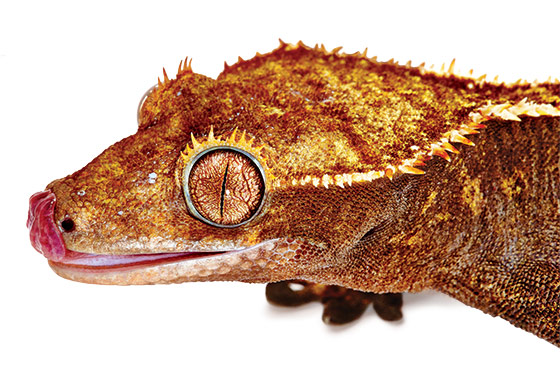
With its canine salons and all-natural-dog-treat bakeries, ours is a city obsessed with its pups. Cats, too—BuzzFeed was founded here, after all. But away from the din of the doggie day cares exist equally passionate pet owners who have forgone allergy-inducing pooches for parrotlets, gerbils, and bearded dragons. Small-pet ownership is on the rise throughout the U.S.; Americans are living with around 116 million fish, birds, small mammals, and reptiles. And folks aren’t just buying hamsters for their 7-year-olds: The city abounds with rat meet-up groups, reptile clubs, and homegrown Instagram feeds starring camera-loving hedgehogs. (And get ready for a House of Cards–fueled guinea-pig boom.) That’s not to say owning a rodent or a reptile is easy; they require strict diets and careful enclosure. What follows is a guide to navigating the complex alt-pet scene—and if you think cat people are obsessed, wait until you meet the woman with 40 hermit crabs.
Small and Furry
The case for a rat and the drawbacks of a chinchilla.
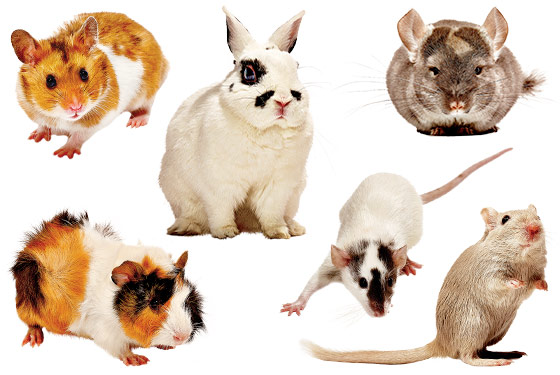
Hamster
Life span: 2 years; Diet: Pellets, some produce; Difficulty Level: Not too bad; Smelly; Bites
These nocturnal fur balls are not big fans of being picked up. Syrians are bigger and more tolerant of handling than dwarves, but it’s best to keep both away from small children. Explains Sean Casey of Sean Casey Animal Rescue: “If kids take them out during the day, the hamsters wake up scared and may bite.”
From $13 at Petco; Sean Casey Animal Rescue
Rat
Life span: 2–3 years; Diet: Rodent blocks, seeds; Difficulty Level: Easy; Kid friendly
These smart creatures can be super-friendly (licking hands, rolling over for tummy rubs). Some can even be toilet-trained, like Britney, owned by Chaya Goodman, an Upper East Side vet tech. “Britney lived most of her life out of her cage; she had a spot in my room where she went to the bathroom, so I just put a pad there.”
From $14 at Petco; Sean Casey Animal Rescue
Rabbit
Life span: 8–12 years; Diet: Grass hey, pellets, dark leafy greens; Difficulty Level: Hard work
Rabbits should get four hours of out-of-cage playtime a day in a bunny-proofed area. The House Rabbit Society offers free home visits and tips on care, and if you’re lucky, volunteer Amy Sedaris just might show up. “I was at Stephen Colbert’s house and was appalled. I said, ‘Shame on you for the size of that hutch!’ But I sent him info and they turned things around.”
Adopt at House Rabbit Society or Petco
Gerbil
Life span: 2–5 years; Diet: Pellets, sunflower seeds, fresh greens; Difficulty Level: Easy; Kid friendly
Gerbils, the clean-cut class presidents of the rodent world, are more tolerant of handling than hamsters, and smell a little better than other rodents. “They’re less aggressive,” says Barbara Burn, author of A Practical Guide to Impractical Pets. This makes them ideal for kids. Plus, they’re active during the day, as opposed to nocturnal hamsters.
From $14 at Petco; Sean Casey Animal Rescue
Chinchilla
Life span: 12–20 years; Diet: Grass, pellets, produce; Difficulty Level: Not too bad; Smelly; Kid friendlyThey might look like football-shaped koalas, but ultrasoft chinchillas would rather not be held. They’re also nocturnal. Says Hell’s Kitchen–based owner Anjali Thomas: “Mine will rattle his cage at night while he’s playing. He also loves to throw his poop out of his cage. I’m always cleaning.”
From $160 at Petco; Chin Friends Chinchilla Rescue
Guinea Pig
Life span: 5–8 years; Diet: Grass hay, pellets, veggies; Difficulty Level: Not too bad; Kid friendly
Guinea pigs need three hours of cage-free exercise a day, and the more human interaction they get the more down-for-cuddles they are. “When mine see me take out their food,” says Mandy Jordan of Have a Heart Guinea Pig Rescue, “they start ‘popcorning’: jumping straight up in the air. It’s this fantastic sign of joy.”
$38 at Petco; Have a Heart Guinea Pig Rescue
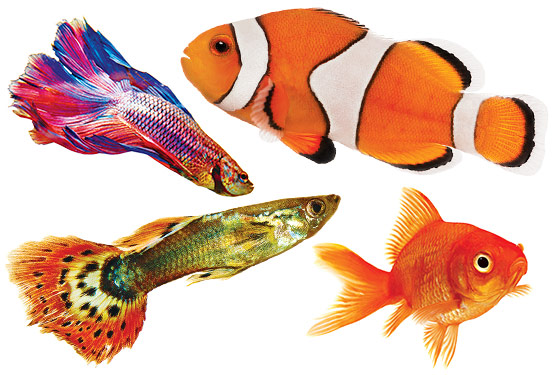
Swimmers
Rethinking the goldfish and funding Nemo.
Freshwater Starters
Life span: 5–7 years, Diet: Commercial fish food, pellets, brine shrimp; Difficulty Level: Not too bad
Guppies, mollies, platies, and swordfish are all good freshwater choices for christening your first aquarium. They’re live bearers (which can be fun to observe), while angelfish, tetras, rams, and danios are egg layers. “Rams will act like dogs—they’ll wag their tails when they’re waiting to be fed,” says Staten Island fish aficionado Denis Vardaro, who has 27 tanks.
From $2 at Fauna
Betta
Life span: 1–3 years; Diet: Commercial fish food; Difficulty Level: Easy; Kid friendly
Kaleidoscopic bettas are great starter fish—as long as they have enough space. Though they’re often sold in cups at pet stores, “they need to be in at least a one-gallon bowl,” says Olivere Arthur of Manhattan Aquariums. “People think you can keep them in small pockets of water, but when you put a fish in a too-small tank, it shortens its life span.”
From $5 at Manhattan Aquariums
Marine Fish
Life span: 2–7 years; Diet: Brine shrimp, zooplankton, algae; Difficulty Level: Hard work
They sure are lovely to behold, but it takes deep pockets to keep marine fish like clownfish, tangs, and gobies at home. “You’re creating a natural reef system inside a glass box,” says Olivere Arthur. “It can be $1,500 to $3,000 to get the lighting and rocks correct for a tank, as well as the necessary corals and invertebrates.”
From $20 at Manhattan Aquariums
Goldfish
Life span: 10 years; Diet: Commercial fish food, finely chopped peas; Difficulty Level: Not too bad; Kid friendly
Goldfish, it turns out, are not ideal for the novice owner. “They don’t have a typical stomach where they can hold a lot of food,” says Daniel Kopulos of Fauna pet store. “They produce a lot of waste, and their tanks need filters and frequent tank cleaning. They also need to be able to eat throughout the day, and most people aren’t available for that.”
From $5 at Manhattan Aquariums
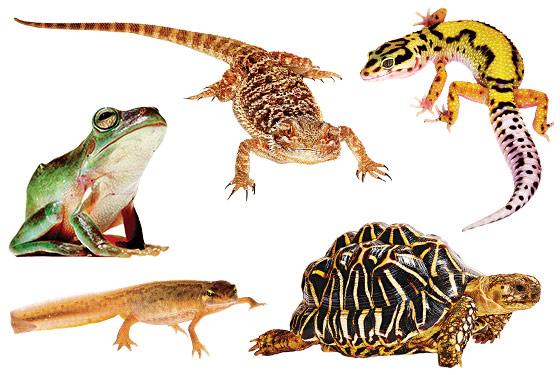
Cold-Blooded and Reptilian
Geckos and bearded dragons love to cuddle—tree frogs, not so much.
Bearded Dragon
Life span: 5–9 years; Diet: Dark greens, berries, mealworms, crickets; Difficulty Level: Not too bad; Kid friendly
The most congenial of reptiles, bearded dragons will pop up when their owners come into the room and can roam free in apartments under supervision. They’ll need UVB lighting and temperature control. Otherwise, “they are one of the best reptiles you can own,” says Dr. Katherine Quesenberry of the Upper East Side Animal Medical Center.*
From $50 at PetSmart
Tree FrogLife span: 3–5 years; Diet: Insects, including crickets and mealworms; Difficulty Level: Not too bad; Kid friendly
Tree frogs are bright and jumpy, which makes them fun to watch—but tricky to handle. Australian tree frogs, which are larger, are less wary of being held. If you must pick up your frog, wash your hands first. “An amphibian’s skin is permeable; lotions or perfumes can make them sick,” says Bronx-based reptile expert Robert Sousa.
From $10 at PetSmart
Newt
Life span: Up to 10 years; Diet: Blackworms, bloodworms, small invertebrates; Difficulty Level: Not too bad; Kid friendly
Like frogs, newts can be striking but do better as look-only pets. “Their skin is even more sensitive than a tree frog’s,” says Robert Sousa, “and they really don’t respond well to being handled.” Instead, they should be left to hang out in a 5 1/2-to-10-gallon tank that’s about two-thirds full of water, ideally with a plant.
Available in summer months from $8 at Fishtown USA
Tortoise
Life span: Up to 100 years; Diet: Dark leafy greens, proteins, yams, beets, sweet potatoes; Difficulty Level: Hard work; Kid friendly
Though sulcatas and other large tortoises can grow to enormous sizes, the more reasonably sized Greek, Hermann’s, and Russian tortoises typically grow to about two feet in length as adults and won’t require their own bedroom. If they’re out of the tank, keep an eye on them. They’re actually quite fast.
From $150 at Fauna; New York Turtle and Tortoise Society
Gecko
Life span: Up to 10 years; Diet: Mealworms, cockroaches, crickets; Difficulty Level: Not too bad; Kid friendly
If you’re going gecko, consider leopards. These popular lizards love to climb up arms and will even run on hamster wheels. Bigger than leaf-tailed and crested geckos, the leopard variety can tolerate the occasionally rough hands of a child. “They’re hearty,” says Lorelei Tibbetts of the Center for Avian and Exotic Medicine. They don’t require UVB lighting, but do need heat lamps.
From $100 at Fauna
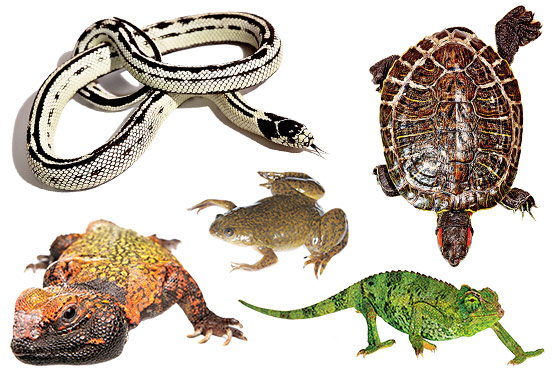
Turtle
Life span: 50–80 years; Diet: Pellets, feeder worms, insects, leafy greens, aquatic plants; Difficulty Level: Hard work; Kid friendly
Red-eared sliders are known for being attentive and will swim to their owners. (Note that the baby ones being sold in Chinatown are illegal.) Turtles require UVB lighting and humidity control and will eventually grow to well over a foot in length.
From $22 at PetSmart; NYTTS
Snakes
Life span: 15–20 years; Diet: Rodents; Difficulty Level: Hard work; Smelly; Bites
Corn snakes will wind around your arm “and just hang out,” says Staten Islander Kelly Marshall of her four-footer. She also owns king and rat snakes—which are nippier and for advanced owners. Though they all eat rodents, it can sometimes work in reverse: Mice may chew on snakes when left in their cages.
From $100 at Fauna; Sean Casey Animal Rescue
Uromastyx Lizard
Life span: 15–20 years; Diet: Dark leafy greens, seeds, lentils; Difficulty Level: Hard work
Temperature control is key for these vegetarians: Their tanks need to be kept at 80 degrees on one end and 130 degrees on the other. Says Queens resident Laurel Halter of her two lizards, “When I first got them, I set up a web camera and I’d check in on them. But once you get the lighting and temperatures under control, you can kind of just coast.”
From $250 at Fauna
Chameleon
Life span: 5–7 years; Diet: Crickets, waxworms, mealworms, flies; Difficulty Level: Hard work
Chameleons are of course known for their ability to change color, as well as extend their tongues the full length of their bodies. But considering their extreme fragility, they’re best as observation-only pets. They also require carefully controlled humidity and cross-ventilated screened enclosures to thrive. You’ll need a misting system as well.
From $75 at Fauna
African Clawed Frog
Life span: 6–10 years; Diet: Pellets, bloodworms, crickets, guppies; Difficulty Level: Hard work; Kid friendly
These frogs have an intense relationship with food, shoveling grub into their wide mouths with their tiny clawlike hands. These eating machines can be with aquarium fish as babies, but, says Robert Sousa, “once they get to be over four inches, they’ll need to be moved out—or your fish will disappear.”
Adopt at Sean Casey Animal Rescue *The original version of this article incorrectly referred to the Animal Medical Center as the Animal Center.
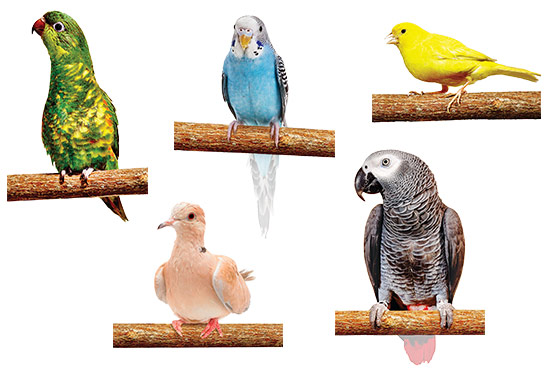
Winged and Feathered
Who will coo, who will wake the neighbors, and who will torture your cats.
Lory
Life span: 12–25 years; Diet: Nectar, pollen, fruit; Difficulty Level: Hard work; Kid friendly
Lories are energetic and apt to play out of the cage as well as learn words. But they’re also explosive poopers. “They poop really frequently, and it’s liquid, so it’s messy,” says New Yorker cartoonist Roz Chast, whose late parrot Marco was a lory. “But they’re so great. He could play fetch—you’d throw a ball, and he’d bring it back in his beak.”
From $900 at Fauna
Parakeet
Life span: 6–18 years; Diet: Pellets, seeds, produce; Difficulty Level: Not too bad; Kid friendly
Parakeets do well in pairs but are more receptive to stepping up onto your finger or sitting on shoulders if they’re kept solo. “Ideally, you should get one that was hand-raised and socialized,” says Dr. Quesenberry. Though it’s not too common, some parakeets can be trained to talk.
From $65 at Fauna
Canary
Life span: 10–15 years; Diet: Pellets, limited seeds, produce; Difficulty Level: Not too bad
The pop stars of the bird world, male canaries produce melodic chirps and trills nonstop. Canaries love to zip around and flap their wings, so make space for a roomier cage. Their small size makes for hypersensitive lungs, meaning they should be kept out of the kitchen; smoke or cooking fumes could kill them.
From $85 at Birdcamp
Dove
Life span: 12–15 years; Diet: Pellets, white millet, pigeon seeds; Difficulty Level: Not too bad; Kid friendly
Doves are ideal for thin-walled apartments, making just a low lovely coo in the morning and evening. Doves that bond with their owners will sit on hands or fly to them—again, more likely if they’re kept single. They’re also known for their fecundity. Says Sean Casey, “A woman just called us who started with a pair and ended up with 12.”
Adopt at Sean Casey Animal Rescue
African Grey Parrot
Life span: 30–50 years; Diet: Pellets, seeds, fruits and vegetables; Difficulty Level: Hard work
African Greys need to be the constant center of attention—but it’s best if all eyes are on them in a calm, quiet home. Greys are among the smartest birds. “If I’m leaving the house,” says Long Island writer Susan Chamberlain, who has two African Greys, “Bert will call out in this very clear voice: ‘I’ll see you later!’ ”
Adopt at Long Island Parrot Society
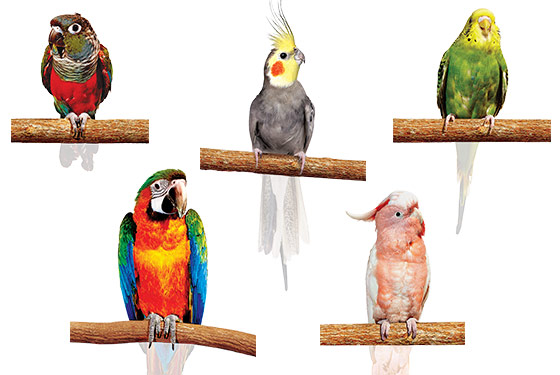
Conure
Life span: 20–30 years; Diet: Pellets, seeds, fruits and vegetables; Difficulty Level: Hard work
In the wild, conures communicate via loud calls. In your apartment, that can be as pleasant as a smoke alarm going off. “I’ve never met a quiet conure,” warns Fauna’s Daniel Kopulos. But these expert mimics, who love to be scratched on their heads, can be taught to lower their voices via positive reinforcement.
From $400 at Fauna
Cockatiel
Life span: 15–20 years; Diet: Pellets, seeds, fruits and vegetables; Difficulty Level: Not too bad; Kid friendly
Cockatiels show their love by hopping on hands, flying to their owners, and gently grooming human faces and eyebrows. “They’re wonderful pets,” says Dr. Quesenberry. “They can live a long time, too. I’ve had people in their 20s come in with cockatiels that they’ve had since they were kids.”
From $175 at Fauna
Parrotlet
Life span: 20 years; Diet: Pellets, fruits and vegetables; Difficulty Level: Not too bad; Kid friendly
Tiny parrotlets are quieter members of the parrot family and thus make great city pets. But, known for their tough-guy complexes, they can nip as they get older. “They’re typically super-sweet babies and then they become these little land sharks,” says Lorelei Tibbetts.
From $259 at Fauna
Macaw
Life span: 35–50 years; Diet: Pellets, seeds, fruits and vegetables; Difficulty Level: Hard work
Macaws can be affectionate, some rolling over on their backs like dogs for belly rubs. But they need to be pampered. “He can be a prima donna—not unlike boyfriends I’ve had,” says artist Cindy Sherman of her macaw, Mr. Frieda. Keep in mind they need large cages and are quite loud.
Adopt at Sean Casey Animal Rescue
Cockatoo
Life span: 60–70 years; Diet: Pellets, seeds, fruits and vegetables; Difficulty Level: Hard work
Cuddly people lovers, cockatoos can also be mischievous. “The other day, I found my cockatoo April had gotten hold of my Swiffer and was trying to smack the cat with it,” says Lorraine Otto of Long Island. Cockatoos require loads of attention and will self-harm when it’s not given to them.
Adopt at Sean Casey Animal Rescue
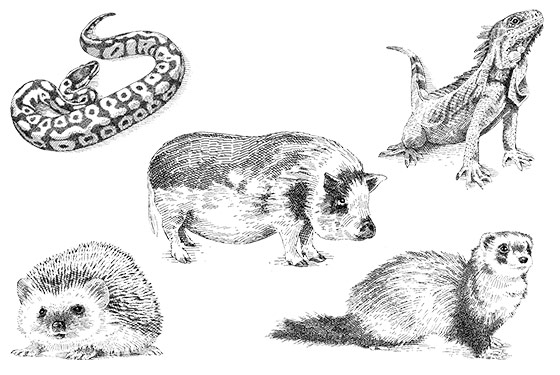
A Ferret at Your Own Risk
Most would agree that dolphins, bobcats, and polar bears—animals prohibited as pets by the Department of Health and Mental Hygiene—don’t make great housemates. The breeds here, which are also outlawed by the city, are actually quite popular among New Yorkers, kept by residents at their own varying degrees of peril. Here’s where to find them—or not—in the tri-state area.
Potbellied Pig
pigplacementnetwork.org
There is no approved rabies vaccination for pigs in the U.S.—but disease exposure is extremely unlikely for these indoor creatures. Potbellies can also grow to be over 150 pounds.
Hedgehog
hedgiemama.com
They can bite, and some scientific studies have shown that they’re susceptible to foot-and-mouth disease, but as captive-bred animals in the U.S., this rarely happens.
Iguana
scalesandtails.org
Iguanas, like all reptiles, are carriers of salmonella. They sometimes grow to be four to five feet in size and can attack when they reach sexual maturity.
Ferret
ferretfarm.org
Though ferrets rarely attack, the city banned them in 1999, citing an incident involving a child. They pose little risk to the natural wildlife within the city and can be vaccinated for rabies.
Ball Python
Nonvenomous snakes known for their generally gentle nature, these constrictors can still bite and grow to be four feet long—large enough to kill small animals. Yeah, maybe don’t get one.